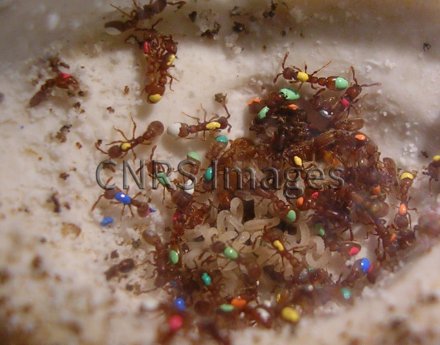Production year
2005

© Emmanuel LECOUTEY/LEEC/CNRS Images
20070001_0989
Fourmis, "Cerapachys biroi", originaires de l'archipel de Ryoukyous (Japon) et de l'île de Taïwan. Ici, les ouvrières sont regroupées à l'intérieur du nid. Au centre, on aperçoit les larves qui donneront la future génération de fourmis. Il s'agit là de la phase de fourragement durant laquelle les ouvrières recherchent activement des proies pour nourrir le couvain. A la nymphose simultanée des larves, la colonie entre alors en phase stationnaire au cours de laquelle les ouvrières vont demeurer au nid et pondre. La nouvelle phase de fourragement sera marquée par l'éclosion des oeufs et l'émergence simultanée de la cohorte de jeunes ouvrières.
The use of media visible on the CNRS Images Platform can be granted on request. Any reproduction or representation is forbidden without prior authorization from CNRS Images (except for resources under Creative Commons license).
No modification of an image may be made without the prior consent of CNRS Images.
No use of an image for advertising purposes or distribution to a third party may be made without the prior agreement of CNRS Images.
For more information, please consult our general conditions
2005
Our work is guided by the way scientists question the world around them and we translate their research into images to help people to understand the world better and to awaken their curiosity and wonderment.